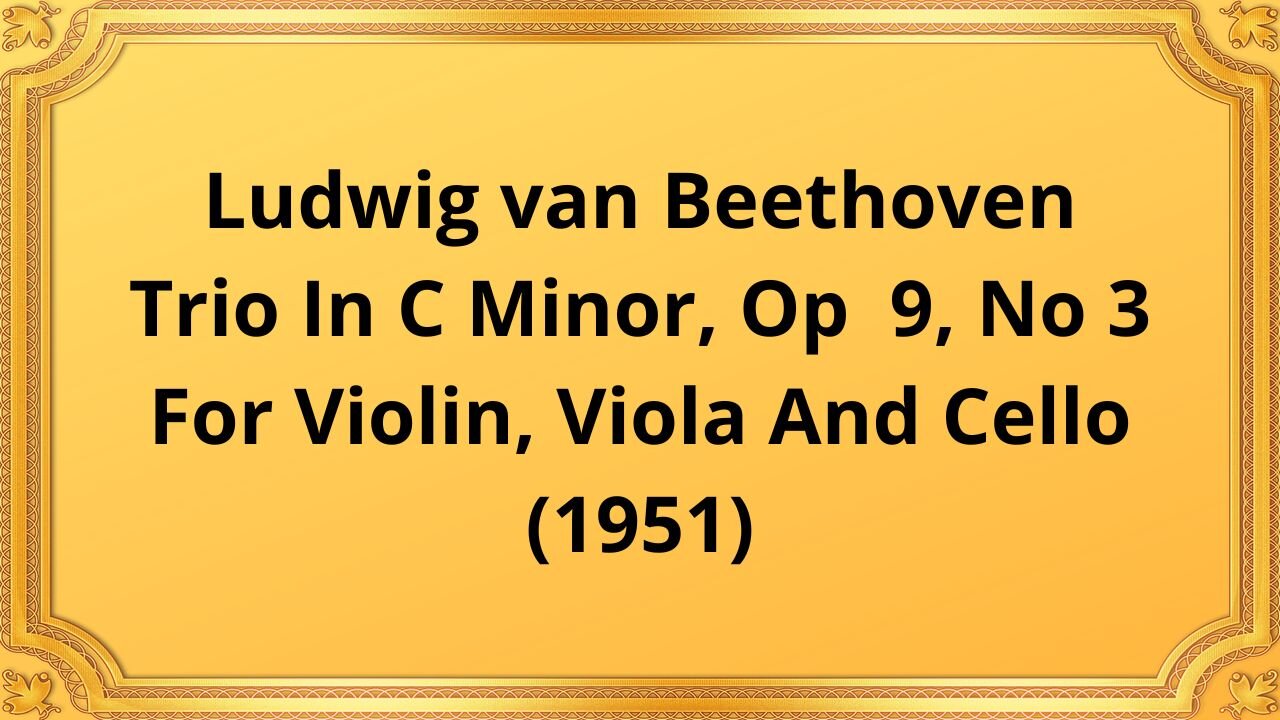Premium Only Content

Ludwig van Beethoven Trio In C Minor, Op 9, No 3 For Violin, Viola And Cello (1951)
#BeethovenTrio #ClassicalMusic #ChamberMusic #Violin #Viola #Cello #MusicHistory #ClassicalComposer #InstrumentalMusic #Op9No3 #MusicAppreciation #MusicalComposition #Beethoven #ClassicalArtistry #18thCenturyMusic
Publication date 1951
JULIUS BAKER, Flute * JOSEPH FUCHS, Violin + LILLIAN FUCHS, Viola + HARRY FUCHS, Cello
Ludwig van Beethoven's Trio in C Minor, Op. 9, No. 3 for Violin, Viola, and Cello is a masterful chamber music composition that showcases Beethoven's innovative approach to classical music. Composed in 1798, this trio is part of a set of three trios, Op. 9, which represent a significant leap in Beethoven's development as a composer, marking the transition from his early works to the more mature and groundbreaking compositions for which he is renowned.
The Trio in C Minor, Op. 9, No. 3 is structured in four movements, a common format for classical chamber music of this era. The first movement, marked Allegro con spirito, introduces the listener to the dramatic and passionate nature of the piece. Beethoven's use of chromaticism and harmonic tension creates a sense of urgency and emotional depth, setting the tone for the rest of the work.
The second movement, Adagio con espressione, provides a contrast to the intensity of the first movement. Here, Beethoven showcases his capacity for lyrical and expressive melodies, allowing each instrument to shine in its own right while maintaining a sense of unity within the trio.
The third movement, Scherzo: Allegro molto e vivace, injects a lively and playful energy into the composition. Beethoven's rhythmic drive and dynamic interplay between the instruments demonstrate his mastery of form and structure, captivating the listener with its spirited and dance-like character.
Finally, the trio concludes with the fourth movement, Finale: Presto, which brings the work to a thrilling and exhilarating close. Beethoven's use of virtuosic passages and contrapuntal writing highlights the technical prowess of the performers while delivering a powerful and satisfying conclusion to the musical journey.
Throughout the Trio in C Minor, Op. 9, No. 3, Beethoven's compositional innovation is evident. He pushes the boundaries of classical chamber music, experimenting with form, harmony, and expression to create a work that is both emotionally compelling and intellectually stimulating. The trio's exploration of the C minor key, known for its dramatic and melancholic qualities, adds an additional layer of depth and complexity to the composition, further showcasing Beethoven's ability to evoke a wide range of emotions through his music.
In conclusion, Ludwig van Beethoven's Trio in C Minor, Op. 9, No. 3 for Violin, Viola, and Cello stands as a testament to Beethoven's genius and his enduring impact on the development of classical music. Its combination of emotional depth, technical brilliance, and innovative spirit cements its place as a cornerstone of the chamber music repertoire, captivating audiences with its timeless beauty and profound musical expression.
-
 2:28:37
2:28:37
Quite Frankly
20 hours ago"2024 Review, Homunculus Flu, Old/New Year Predictions" 12/30/24
123K19 -
 14:04:17
14:04:17
RonjnJeremy
22 hours ago $10.06 earnedClassic Wow 20th Anniversary edition HC SF, Rogue..PT8 lvl 46+ Just need to stay alive...
135K7 -
 1:50:28
1:50:28
Jesús Enrique Rosas
19 hours agoEp. 51: Gates wants CENSORSHIP, Colbert MESSES UP, AOC meltdown, Hanks LEAVING and MOAR!
140K100 -
 1:45:47
1:45:47
The Quartering
21 hours agoHuge Censorship Law To Pass, Trump Endorses Johnson, TikTok is Saved? & Today's News!
161K99 -
 55:59
55:59
The Amber May Show
20 hours ago $2.05 earnedCommon Behaviors That May Indicate You Are In An Abusive Relationship| Grace Bishara
45.6K2 -
 1:54:42
1:54:42
MTNTOUGH Fitness Lab
16 hours agoThe MTNTOUGH 8 Week LIVE READY Challenge w/ Kyle Kamp | MTNPOD #97
35.4K1 -
 2:25:15
2:25:15
WeAreChange
15 hours agoTrump Make CRYPTIC Post! Bill Gates Requested Meeting With Elon Musk At Mar-a-Lago??
50.8K30 -
 53:39
53:39
PMG
3 days ago $3.98 earned"Allegations Against Diddy & Usher, $150K Bounty on Trump, RINO Speaker Caves w/Steve Baker"
33.5K7 -
 1:31:21
1:31:21
Tucker Carlson
20 hours agoBrigham Buhler: UnitedHealthcare CEO Assassination, & the Mass Monetization of Chronic Illness
255K532 -
 2:29:04
2:29:04
Nerdrotic
21 hours ago $14.00 earnedHappy New Years - Nerdrotic Nooner 454
96.9K22